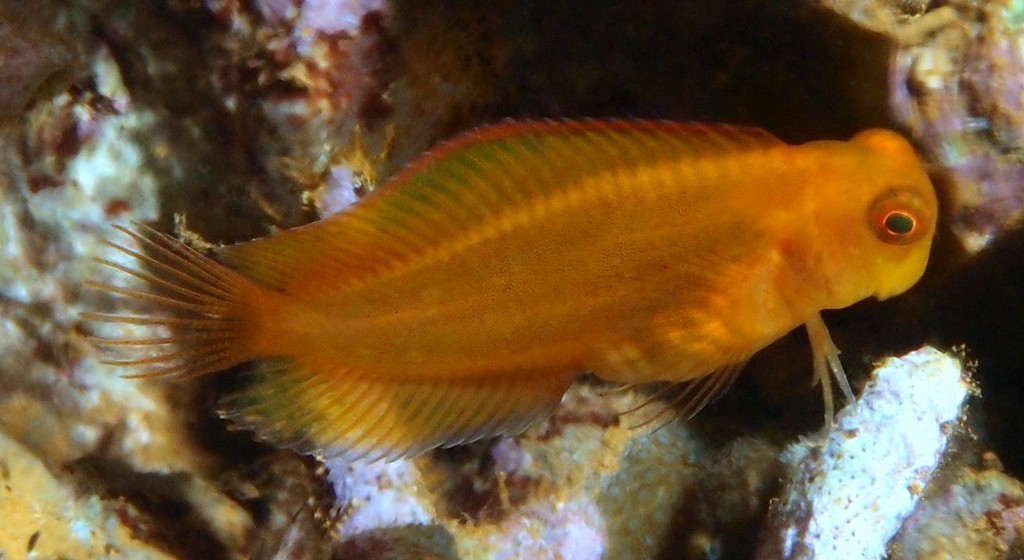ATROSALARIAS HOLOMELAS - (GUNTHER, 1872)
Actinopterygii (Gigaclass) > Actinopteri (Class) > Teleostei (Subclass) > Blenniiformes (Order) > Blennioidei (Suborder) > Blenniidae (Family) > Salariinae (Subfamily) > Atrosalarias (Genus)
Blennie de corail foncé, Black blenny, Brown coral blenny, Brown coral-blenny, Dusky blenny, Indo-kaeru-uo, 全黑烏鳚, インドカエルウオ,
Synonymes
Atrosalarias fuscus holomelas (Günther, 1872)
Atrosalarias fuscus homomelas (Günther, 1872)
Salarias holomelas (Günther, 1872)
-------------------------
Description
Blennie de corail foncé, Black blenny, Brown coral blenny, Brown coral-blenny, Dusky blenny, Indo-kaeru-uo, 全黑烏鳚, インドカエルウオ,
Synonymes
Atrosalarias fuscus holomelas (Günther, 1872)
Atrosalarias fuscus homomelas (Günther, 1872)
Salarias holomelas (Günther, 1872)
-------------------------
Description
Dorsal spines (total): 10; Dorsal soft rays (total): 19-21; Anal spines: 2; Anal soft rays: 18-20; Vertebrae: 33-34. Body comparatively short, its depth being contained thrice and one eighth in the total length (without caudal). Anterior profile of the forehead nearly vertical. Canine teeth none. No orbital tentacle, no crest on the head. The dorsal fin is not notched; This fin, as well as the anal, is elevated, all the spines and rays terminating in very fine filaments; Both fins connected by a short membrane with the caudal, which is also produced. Max. length: 14.5 cm TL. Depth range: 1 - 15 m.
Color
The juveniles are a uniform yellow. A dark brown to blackish blenny, sometimes with a brownish-yellow tail.
Etymology
Atrosalarias: from Latin, ater = dull black, dark + salarias, name given by M. Cuvier in 1816 (he didn't explain his choice). Referring to largely uniform dark-brown coloration of Atrosalarias phaiosoma (=fuscus); Salarias, a related genus and original genus of Atrosalarias fuscus.
holomelas: from Latin prefix, holo = whole + from Latin, melas = black, dark. Described as entirely black.
Original description: Salarias holomelas Günther, 1872 - Type locality: Cebu, Philippines.
Distribution
Eastern Indian Ocean, western Pacific: eastern Indonesia east to Marshall and Society islands, north to Ryukyu Islands, south to Shark Bay (Western Australia), southern Great Barrier Reef (Queensland, Australia) and New Caledonia.
Biology
Lives among branches of live and dead corals of sheltered shallow reefs. Oviparous. Eggs are demersal and adhesive, and are attached to the substrate via a filamentous, adhesive pad or pedestal. Larvae are planktonic, often found in shallow, coastal waters.
Etymology
Atrosalarias: from Latin, ater = dull black, dark + salarias, name given by M. Cuvier in 1816 (he didn't explain his choice). Referring to largely uniform dark-brown coloration of Atrosalarias phaiosoma (=fuscus); Salarias, a related genus and original genus of Atrosalarias fuscus.
holomelas: from Latin prefix, holo = whole + from Latin, melas = black, dark. Described as entirely black.
Original description: Salarias holomelas Günther, 1872 - Type locality: Cebu, Philippines.
Distribution
Eastern Indian Ocean, western Pacific: eastern Indonesia east to Marshall and Society islands, north to Ryukyu Islands, south to Shark Bay (Western Australia), southern Great Barrier Reef (Queensland, Australia) and New Caledonia.
Biology
Lives among branches of live and dead corals of sheltered shallow reefs. Oviparous. Eggs are demersal and adhesive, and are attached to the substrate via a filamentous, adhesive pad or pedestal. Larvae are planktonic, often found in shallow, coastal waters.
Similar species
Atrosalarias fuscus (Rüppell, 1838) - Reported from Red Sea; Indian Ocean: East Africa (Mozambique, Tanzania, Kenya) and Socotra (Yemen) east to Nicobar Islands (India) and western Sumatra (Indonesia).
Atrosalarias fuscus (Rüppell, 1838) - Reported from Red Sea; Indian Ocean: East Africa (Mozambique, Tanzania, Kenya) and Socotra (Yemen) east to Nicobar Islands (India) and western Sumatra (Indonesia).
Last update: 20, March 2023
